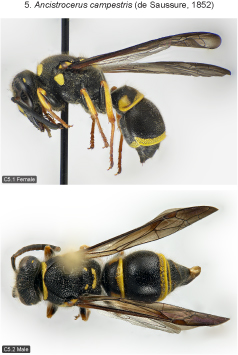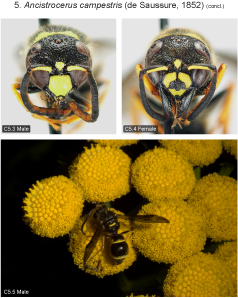
| Home | Table of contents | Keys | Species list | Glossary | Image data | PDF | Cite this article | Feedback | Updates |
Identification Atlas of the Vespidae (Hymenoptera, Aculeata) of the northeastern Nearctic region
CJAI 05, February 19, 2008
doi: 10.3752/cjai.2008.05
Matthias Buck, Stephen A. Marshall, and David K.B. Cheung
Department of Environmental Biology, University of Guelph, Guelph, Ontario, Canada N1G 2W1
Next species | Previous species | Key
5. Ancistrocerus campestris (de Saussure, 1852)
Figs B3.1, 36; C5.1–5.
Species recognition. Ancistrocerus campestris is easily recognised by the combination of two characters: sternum 2 with median furrow near base and pronotum without distinct carina.
Variation. Fore wing length 6.5–9 mm (♂♂), 9–11 mm (♀♀). Hind margin of tergum 2 slightly thickened in female, not reflexed; in male moderately to very strongly thickened and reflexed. Punctation in preapical area of tergum 2 moderate to coarse in female, in male coarse to extremely coarse with aciculate interspaces. Female clypeus yellow with a black discal spot that is usually connected by a narrow stripe to the dorsal margin of the clypeus; ventrolateral corners of discal spot rarely extending to clypeal margin. Postocular spot sometimes very small in male. Scutellum with a pair of well-developed yellow spots, sometimes small in male. Metanotal band complete, in male exceptionally narrowly interrupted at middle. Terga 1–3 fasciate; fascia of tergum 3 rarely absent in female; in male tergum 4 often fasciate as well. Lateral forward extension of apical fascia of tergum 1 usually broad, sometimes strongly extended towards middle. Tergum 2 in two examined males with a pair of small yellow discal spots. Sternum 2 fasciate; sternum 3 usually with posterolateral yellow spots, these sometimes missing, rarely with interrupted or complete fascia.
Distribution. Canada: ON. Eastern U.S.: NH south to FL, west to MN, SD, KS, TX (Bequaert 1944a, Krombein 1979).
Biology. Nests in borings in wood, sumac stems and old mud dauber nests. Nest partitions and closing plugs are made of mud. Prey consists of caterpillars of Amphisbatidae, and Gelechiidae (Krombein 1967, 1979).
Next species | Previous species | Key
| Home | Table of contents | Keys | Species list | Glossary | Image data | PDF | Cite this article | Feedback | Updates |


